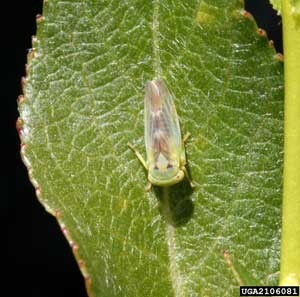
Identification
There are many species of leafhoppers. Some are brown or green in color, while others are green and red with white markings. Look for slender 1/8-inch long wedge-shaped bugs that jump or fly when disturbed. Eggs overwinter on plant leaves and stems and hatch into nymphs in the spring. Adults may also overwinter by hibernating in leaf debris or in the case of some species, they may migrate south for the winter and return north again in the spring.
Favorite Plants
Apples, beans, beets, carrots, cucumbers, muskmelons, and potatoes are their favorites, but they will attack almost any fruit or vegetable crop.
Damage
Adults and nymphs suck the juices from leaves, often on the undersides. Leafhoppers have toxic saliva, which causes the tips to burn (known as "hopper burn"). Sucking the juices from the leaves causes them to turn yellow and curl and either stunts the plant's growth or kills it. Feeding also spreads viral diseases.
Organic Methods of Control:
Cultural and Mechanical
- Cover plants with floating row covers.
- Interplant geraniums or petunia.
- Remove adults and nymphs with a strong jet of water from the garden hose.
- Use fall plowing to destroy crop debris.
Biological
- Attract native predators to the garden like dragonflies, which eat adults and nymphs.
- Release lacewings to feed on eggs.
Chemical
- Spray with an insecticidal soap early in the day when bugs are less active.
- For severe infestations, spray neem, pyrethrins as a last resort.
